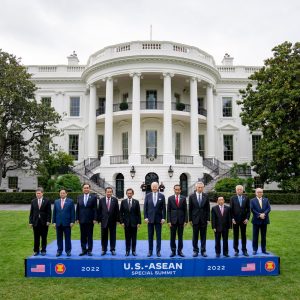The United States has lost influence to China in Southeast Asia over the past five years, a leading Australian think-tank said today, suggesting that Washington’s efforts to rally its allies and partners in the region have yet to bear much fruit – at least in relative terms.
According to a report released today by Sydney’s Lowy Institute, China has increased the overall margin of its influence in Southeast Asia, while making inroads into areas that have traditionally been American strengths.
The report was based on data compiled since 2018 for Lowy’s annual Asia Power Index, which “measures resources and influence to assess the relative power of states in Asia.” The Index gauges influence in four categories – economic relationships, defense networks, diplomatic influence, and cultural influence – each of which is assigned a rating out of 100.
The new report showed that in 2018, China led the U.S. 52–48 for influence in the region. In 2022, this lead increased to 54–46. The U.S. remains more influential than China in just two nations – the Philippines and Singapore– and even then, by relatively narrow margins: 52–48 in the former case, and 51–49 in the latter. This is down from three nations (Singapore, Vietnam, and the Philippines) in 2018, and one nation (Thailand) in which it was equally influential to China.
China’s influence is strongest in Laos, Cambodia, and Myanmar, which saw relatively lopsided margins of 71–29, 69–31, and 66-34, respectively. But it is also rated as more influential in Indonesia (60–40), Malaysia (63–37), and Thailand (53-47). China also enjoyed an edge over the U.S. in Vietnam (53–47), the national identity of which has been forged and tempered by repeated bruising encounters with Chinese power.
“Clearly there is a competition for influence in Southeast Asia, and the balance is shifting noticeably towards China,” Susannah Patton of the Lowy Institute said in an interview with the Australian Financial Review. While the U.S. and China were not the only powers in Southeast Asia, she added, they “are the most important external influences and the direction of travel is not positive for the U.S.”
Since 2018, the U.S. has lost the most overall influence in Malaysia, slipping seven points, which the report put down to the increased defense cooperation between Beijing and Kuala Lumpur. Washington also lost five points in the case of both Indonesia and Brunei. In the former country, too, “the last five years have seen China make great strides in its economic relationships and defense networks.”
China’s edge in influence is clearly a reflection of its massive economic presence in the region, particularly its near-trillion-dollar trade relationship (at least according to Chinese statistics) with the 10 nations of the Association of Southeast Asian Nations (ASEAN). According to the Lowy report, China enjoyed a 70–30 advantage over the U.S. in 2022, increasing its margin of advantage from five years earlier. Indeed, it leads on this measure by margins of at least 60–40 in every nation except Vietnam (52–47), and as much as 92–8 in the case of Laos and 84–16 in the case of Brunei.
China also led in terms of diplomatic influence, by a narrower margin of 56–44, as well as in every individual nation, including Indonesia, where the U.S. scored most highly in terms of diplomatic influence. This reflects the intense number of high-level visits and diplomatic exchanges with which it engages Southeast Asia.
The report found that the U.S. continues to have a strong advantage in terms of its defense networks (72–28) and is a leader in terms of its cultural influence (52–48), though its lead in both of these areas has narrowed slightly since 2018.
While the strategic competition in Southeast Asia is far from binary, the report usefully reflects each of the major powers’ relative strengths, and the broad trends at play. Above all, the Lowy findings underscore the idea, now increasingly acknowledged by Washington policymakers who work on Southeast Asia, that U.S. security engagement with Southeast Asia runs far ahead of its economic engagement, despite the considerable amount of U.S. trade and investment in the region.
The results might come as a surprise, given the economic impacts of Beijing’s “zero-COVID” policy and its abrasive “wolf warrior” diplomacy, as well as the increased engagement with the region under President Joe Biden. However, China’s strengths – particularly its growing economic and diplomatic influence – can be interpreted as a reflection of its proximity to the region, and the consequently greater priority that it places on it. It could also reflect the fact that the U.S. is more engaged globally, and thus has many other priorities vying for the attention of U.S. officials.
All this suggests that to a large extent, China’s advantages in the region are structural. No matter how much energy the U.S. devotes to the region – and it can clearly do a lot more – the map will continue to exert a certain asymmetrical gravitational force.

































